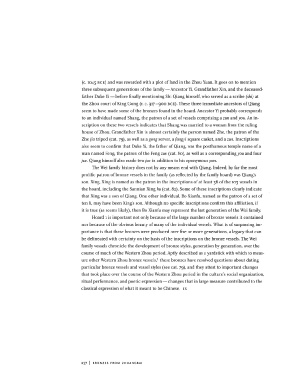Page 238 - The Golden Age of Chinese Archaeology: Celebrated Discoveries from the People’s Republic of China
P. 238
(c. 1045 BCE) and was rewarded with a plot of land in the Zhou Yuan. It goes on to mention
three subsequent generations of the family — Ancestor Yi, Grandfather Xin, and the deceased
father Duke Yi — before finally mentioning Shi Qiang himself, who served as a scribe (shi) at
the Zhou court of King Gong (r. c. 917-900 BCE). These three immediate ancestors of Qiang
seem to have made some of the bronzes found in the hoard. Ancestor Yi probably corresponds
to an individual named Shang, the patron of a set of vessels comprising a zun and you. An in-
scription on these two vessels indicates that Shang was married to a woman from the ruling
house of Zhou. Grandfather Xin is almost certainly the person named Zhe, the patron of the
Zhejia tripod (cat. 79), as well as a gong server, afangyi square casket, and a zun. Inscriptions
also seem to confirm that Duke Yi, the father of Qiang, was the posthumous temple name of a
man named Feng, the patron of the Feng zun (cat. 80), as well as a corresponding you and four
jue. Qiang himself also made two jue in addition to his eponymous pan.
The Wei family history does not by any means end with Qiang. Indeed, by far the most
prolific patron of bronze vessels in the family (as reflected by the family hoard) was Qiang's
son, Xing. Xing is named as the patron in the inscriptions of at least 36 of the 103 vessels in
the hoard, including the Sannian Xing hu (cat. 82). Some of these inscriptions clearly indicate
that Xing was a son of Qiang. One other individual, Bo Xianfu, named as the patron of a set of
ten li, may have been Xing's son. Although no specific inscriptions confirm this affiliation, if
it is true (as seems likely), then Bo Xianfu may represent the last generation of the Wei family.
Hoard i is important not only because of the large number of bronze vessels it contained
nor because of the obvious beauty of many of the individual vessels. What is of surpassing im-
portance is that these bronzes were produced over five or more generations, a legacy that can
be delineated with certainty on the basis of the inscriptions on the bronze vessels. The Wei
family vessels chronicle the development of bronze styles, generation by generation, over the
course of much of the Western Zhou period. Aptly described as a yardstick with which to meas-
1
ure other Western Zhou bronze vessels, these bronzes have resolved questions about dating
particular bronze vessels and vessel styles (see cat. 79), and they attest to important changes
that took place over the course of the Western Zhou period in the culture's social organization,
ritual performance, and poetic expression — changes that in large measure contributed to the
classical expression of what it meant to be Chinese. ES
237 | B R O N Z E S FRO M Z H U A N C B A I

